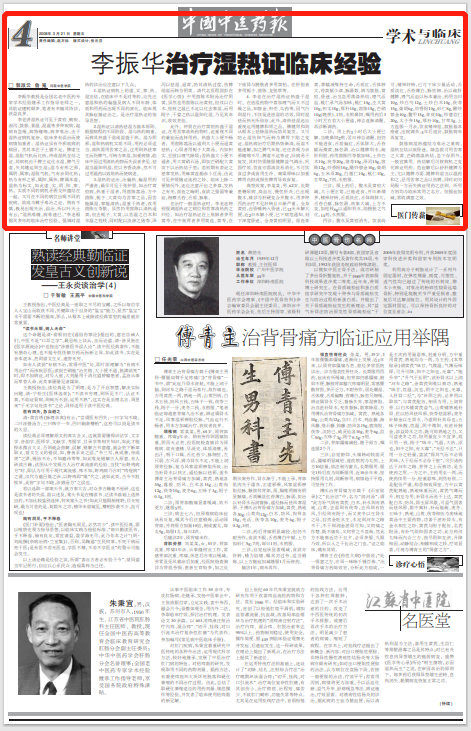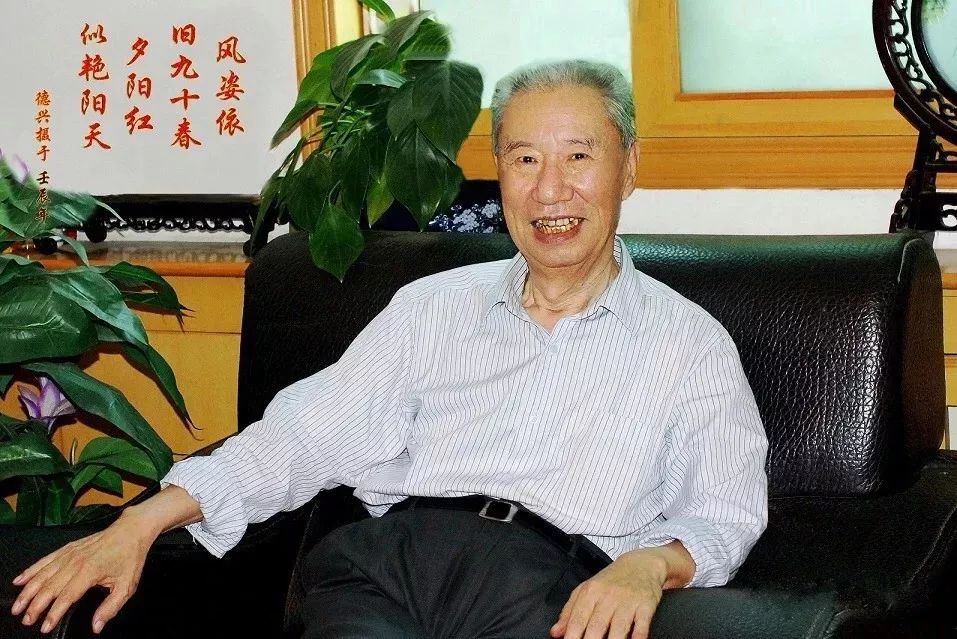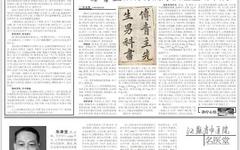
 ▲ Master Li Zhenhua (1924.11-2017.5)
▲ Master Li Zhenhua (1924.11-2017.5)
Li Zhenhua, the first Master of Traditional Chinese Medicine, served as the chief physician at the Henan Provincial Hospital of Traditional Chinese Medicine, and was one of the national renowned experts in traditional Chinese medicine. He has made significant contributions in clinical practice. Below, we present Master Li’s experience in treating Damp-Heat Syndrome for the benefit of colleagues.
Master Li stated that Damp-Heat Syndrome can manifest in various diseases such as jaundice, dysentery, diarrhea, abdominal distension, summer heat, and damp heat, with onset being either acute or chronic, and the condition often being difficult to treat.Due to the complex pathogenesis of Damp-Heat Syndrome, there are many cases of misdiagnosis that can worsen the condition.Although external pathogens can cause Damp-Heat Syndrome, its root cause lies in the deficiency of the Earth element, leading to spleen deficiency which generates dampness, obstructing the flow of Qi and transforming into heat, ultimately resulting in the syndrome of Damp-Heat intermingling.The pathogenesis involves the spleen’s role in the transportation and transformation of water and dampness; when the spleen Qi is deficient, it fails to perform its function, leading to dampness accumulation;dampness is a tangible evil, belonging to Yin and cold;when dampness obstructs Qi, excess Qi can transform into heat;heat is also a tangible evil, belonging to Yang and heat.The spleen is fundamentally deficient, while Damp-Heat is a manifestation of excess; thus, the interplay of deficiency and excess, Yin and Yang, cold and heat, with fundamentally different pathogenesis, intertwines and can present as different diseases in various locations, making it a challenging and difficult syndrome to treat. A slight misstep can easily lead to misdiagnosis or mistreatment.Therefore, Ye Tianshi stated:“Damp-Heat is difficult to deal with, and the disease is hard to resolve quickly.”Based on his years of clinical experience, Master Li emphasized the following points in the diagnosis and treatment of Damp-Heat:1. The pathogenesis of Damp-Heat Syndrome involves the interplay of deficiency, excess, cold, heat, and dampness, which are not equal in clinical practice. Attention should first be paid to the predominance of dampness and heat, as well as the different evolutions that may occur based on the patient’s age, constitution, and medication. Clinical observation of pulse and symptoms should guide treatment, which is the guiding principle for treating Damp-Heat Syndrome.2. The basic principle for treating Damp-Heat Syndrome is to clear heat and eliminate dampness, distinguishing whether heat is predominant over dampness or vice versa based on the different stages of the disease. Dampness is a Yin pathogen, and the pathogenesis of dampness and heat is fundamentally different, so medication must be appropriate. Clearing heat requires the use of bitter and cold substances; excessive use can lead to the transformation of heat into cold, harming spleen Qi, which can turn into cold dampness and worsen the condition. In clinical practice, there are many cases of errors due to excessive use of heat-clearing medications. To eliminate dampness, one should warm Yang and promote dampness elimination, supplemented with aromatic and light diuretics, but care must be taken not to overuse warming medications, which can exacerbate heat and worsen the disease.3. The treatment of Damp-Heat Syndrome requires rigorous medication selection for heat-predominant or damp-predominant conditions, as seen in Zhang Zhongjing’s practices. For treating jaundice with heat predominating over dampness, Yin Chen Hao Decoction is used. The formula includes Yin Chen (Artemisia capillaris), Zhi Zi (Gardenia), and Da Huang (Rhubarb), all of which are bitter and cold substances, as bitterness can dry dampness and cold can clear heat; when dampness predominates over heat, Yin Chen Wu Ling San is used, still incorporating Yin Chen to clear heat and reduce jaundice, but removing Zhi Zi and Da Huang, and adding Bai Zhu (Atractylodes macrocephala) and Gui Zhi (Cinnamon twig) to warm and transform dampness, along with Zhu Ling (Polyporus) and Ze Xie (Alisma) to eliminate dampness and reduce jaundice, preventing excessive heat-clearing from harming the spleen and turning into Yin jaundice. Renowned physician Cheng Guopeng from the Qing Dynasty used Yin Chen Shu Fu Decoction to treat Yin jaundice, also using Yin Chen to treat jaundice, but found that the warmth of Bai Zhu and Gui Zhi was insufficient to resolve cold dampness, thus adding Fu Zi (Aconite) and Gan Jiang (Dried ginger) to warm Yang and transform dampness, demonstrating his profound insight and achieving excellent results.Additionally, Zhang Zhongjing emphasized the importance of selecting medications based on different accompanying symptoms when using bitter and cold heat-clearing medications for treating jaundice with heat predominating over dampness. For those with heat and difficulty in urination, Yin Chen Hao Decoction is used to promote urination and clear heat; for those with irritability, Zhi Zi Da Huang Decoction is used, adding Zhi Shi (Bitter orange) and Dou Chi (Fermented soybeans) to regulate Qi and relieve irritability; if there is heat with constipation, Da Huang Nao Shi Decoction is used, adding Mang Xiao (Glauber’s salt) to Da Huang to purge heat accumulation; if there are initial symptoms of exterior syndrome with chills and fever, Ma Huang Lian Qiao Chi Xiao Dou Decoction is used. This illustrates Zhang Zhongjing’s skill in selecting medications based on symptoms. In clinical practice, in addition to the conditions of urination, attention should also be paid to the quantity of sweating, presence of fever, complexion clarity, and appetite strength, as well as careful observation of tongue coating, tongue quality, and pulse condition.In treating general Damp-Heat Syndrome, Master Li particularly emphasized the location of the disease and the meridian affinity of bitter and cold heat-clearing medications. For Damp-Heat in the upper jiao (lung), Huang Qin (Scutellaria) is often used; in the middle jiao (stomach), Huang Lian (Coptis) and Huang Qin are used; in the lower jiao (kidney and bladder), Huang Bai (Phellodendron) is used; in the liver and gallbladder, Zhi Zi, Yin Chen, and Long Dan Cao (Gentiana) are used.4. When treating Damp-Heat Syndrome with heat predominating over dampness, Master Li preferred to add Qi-regulating and non-drying herbs such as Yu Jin (Curcuma), Zhi Ke (Bitter orange), and Wu Yao (Lindera) to the dampness-eliminating herbs, as Qi movement promotes dampness movement, enhancing the effect of dampness elimination, while also ensuring that dampness is eliminated and heat has no place to reside. Furthermore, clearing heat and eliminating dampness should also emphasize the use of herbs that strengthen the spleen and stomach; when the spleen and stomach are strong, dampness and heat can be fundamentally eliminated, preventing recurrence, and also preventing dampness from injuring Yang Qi and leading to the sinking of the spleen and stomach. In the later stages of treating Damp-Heat, as heat gradually clears but dampness cannot be resolved quickly, along with the spleen Qi not recovering, it often presents as lingering evil, spleen deficiency, and poor transportation, making old diseases prone to recurrence. At this time, it is still necessary to continue taking herbs to strengthen the spleen and benefit Qi to consolidate the therapeutic effect. Diet should also be light and easily digestible, avoiding excessive intake or consumption of raw, cold, or rich foods that can burden the spleen and stomach or harm them, leading to recurrence.Typical CaseMr. Li, male, aged 62. He had long suffered from diabetes, hypertension, and chronic hepatitis. He developed ascites and was diagnosed with liver cirrhosis with ascites. After using various Western medications without improvement and worsening condition, he presented with full-body jaundice, transitioning from drowsiness to coma, and had not defecated for 12 days, with no urination for the past 2 days, and was given a critical condition notice. At this moment, he was in deep coma, with significant jaundice, a greenish-yellow complexion, relying on intravenous fluids to sustain life, with a red tongue, swollen tongue body, yellow greasy coating, and slippery rapid pulse.Diagnosis: abdominal distension, jaundice, coma. Treatment should urgently use methods to purge heat accumulation and regulate Qi and invigorate blood. Modified Tao Ren Cheng Qi Decoction: Tao Ren (Peach kernel) 10g, Sheng Da Huang (Raw rhubarb) 10g, Zhi Shi 10g, Hou Po (Magnolia bark) 10g, Yin Chen (Artemisia capillaris) 15g, Mang Xiao (Glauber’s salt) 10g (to be decocted in the evening). One dose, administered via nasal feeding. It was instructed that if urination and defecation occur about 3 hours after taking the medication, the patient’s consciousness would gradually clear, and then re-evaluate and adjust the medication.Second Diagnosis:Three hours after taking the above medication, urination and defecation had occurred. That evening, two doses were administered via nasal feeding, and the next day the patient regained consciousness but still could not eat, with a red tongue, swollen tongue body, slightly yellow greasy coating, and a slippery pulse. Treatment focused on strengthening the spleen, promoting water metabolism, and soothing the liver and benefiting the gallbladder.Medication: Modified Yin Chen Si Ling San: Tu Chao Bai Zhu (Atractylodes macrocephala) 10g, Fu Ling (Poria) 20g, Zhu Ling (Polyporus) 10g, Ze Xie (Alisma) 15g, Yin Chen (Artemisia capillaris) 12g, Chao Xiang Fu (Cyperus) 10g, vinegar-fried Yu Jin (Curcuma) 10g, Chai Hu (Bupleurum) 6g, corn silk 20g, Bai Dou Kou (Cardamom) 10g, Tao Ren (Peach kernel) 10g, Gan Cao (Licorice) 3g. Seven doses, to be decocted and taken orally.Third Diagnosis:After taking the above medication, abdominal distension and jaundice significantly reduced, urination and defecation returned to normal, and the patient was able to eat, gradually increasing intake, with improved spirit, a pale red tongue, slightly swollen tongue body, white greasy coating, and a slippery pulse. The heat symptoms significantly reduced, and the previous formula remained unchanged, adding Gui Zhi (Cinnamon twig) 6g to promote Yang and benefit water metabolism, assisting the bladder Qi transformation, with 14 doses, to be decocted and taken orally.Fourth Diagnosis:Abdominal distension and jaundice disappeared, diet was acceptable, spirit improved, and the patient was able to get out of bed for light activities, with a pale red tongue, thin white coating, and a fine slippery pulse. Treatment focused on soothing the liver, strengthening the spleen, regulating Qi, and invigorating blood to address both the root and branch.Medication: Dang Gui (Angelica) 10g, Chao Bai Shao (White peony) 12g, Tu Chao Bai Zhu (Atractylodes macrocephala) 10g, Fu Ling (Poria) 15g, Chai Hu (Bupleurum) 6g, Chao Xiang Fu (Cyperus) 10g, Sha Ren (Amomum) 8g, vinegar-fried Yu Jin (Curcuma) 10g, Bie Jia (Tortoise shell) 15g, Qing Pi (Green tangerine peel) 10g, Chao Yi Yi Ren (Coix seed) 20g, Tai Zi Shen (Pseudostellaria) 15g, Tu Chao Hou Po (Magnolia bark) 10g, Gan Cao (Licorice) 3g. The above formula was taken continuously for over a month, with good diet and spirit, and abdominal distension was basically cured, allowing for discharge and recuperation. Five years later, follow-up showed that the abdominal distension had not recurred.Abdominal distension due to Damp-Heat accumulation is a difficult and serious condition. Damp-Heat intermingling leading to coma can only be treated urgently with bitter and cold Da Huang (Rhubarb) and Mang Xiao (Glauber’s salt) to purge heat accumulation, while generally, caution should be exercised. After resolving heat accumulation, medications should be selected based on the changes in pathogenesis. After critical symptoms are resolved, the focus should be on soothing the liver and strengthening the spleen, especially strengthening the spleen. Strengthening the spleen and eliminating dampness should be done with warming herbs, avoiding bitter and cold substances that harm the spleen, while also not limiting to a single formula and losing the principle of differential medication. The formulas used are all commonly used in clinical practice, but adjustments based on symptoms often yield satisfactory results.
Important Statement:
Due to individual differences in constitution and condition, the formulas and dosages in this case are only applicable to the patient at that time. Without proper TCM diagnosis and treatment, do not replicate the prescriptions and dosages in this case. Readers in need should seek treatment at a legitimate hospital to avoid delaying their condition. ■
【Source: China Traditional Chinese Medicine News, content selected from “China Traditional Chinese Medicine News” March 21, 2008, Fourth Edition, Guo Shuyun, Lu Wei, Henan University of Traditional Chinese Medicine】Recommended Reading





